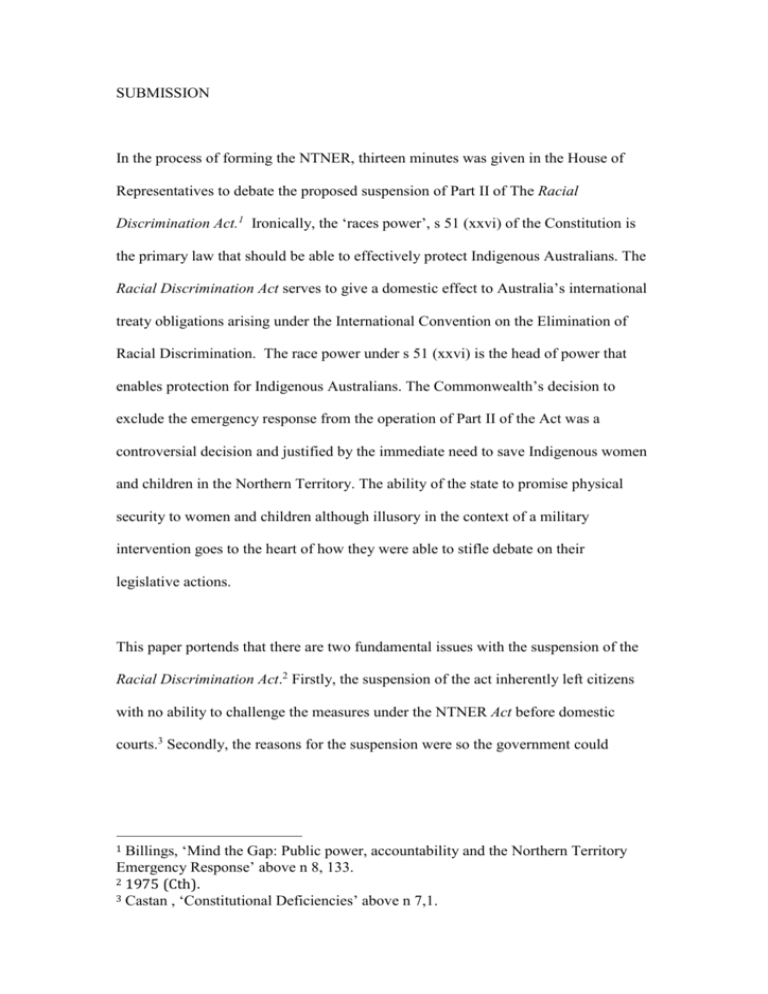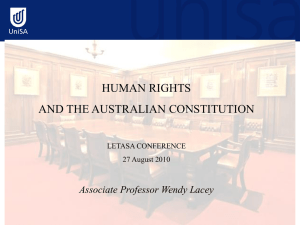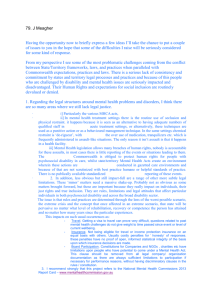Rachel - Deloitte Access Economics
advertisement

SUBMISSION In the process of forming the NTNER, thirteen minutes was given in the House of Representatives to debate the proposed suspension of Part II of The Racial Discrimination Act.1 Ironically, the ‘races power’, s 51 (xxvi) of the Constitution is the primary law that should be able to effectively protect Indigenous Australians. The Racial Discrimination Act serves to give a domestic effect to Australia’s international treaty obligations arising under the International Convention on the Elimination of Racial Discrimination. The race power under s 51 (xxvi) is the head of power that enables protection for Indigenous Australians. The Commonwealth’s decision to exclude the emergency response from the operation of Part II of the Act was a controversial decision and justified by the immediate need to save Indigenous women and children in the Northern Territory. The ability of the state to promise physical security to women and children although illusory in the context of a military intervention goes to the heart of how they were able to stifle debate on their legislative actions. This paper portends that there are two fundamental issues with the suspension of the Racial Discrimination Act.2 Firstly, the suspension of the act inherently left citizens with no ability to challenge the measures under the NTNER Act before domestic courts.3 Secondly, the reasons for the suspension were so the government could Billings, ‘Mind the Gap: Public power, accountability and the Northern Territory Emergency Response’ above n 8, 133. 2 1975 (Cth). 3 Castan , ‘Constitutional Deficiencies’ above n 7,1. 1 implement measures without delay and uncertainty. 4 The Commonwealth posited that its actions constituted “special measures” and should therefore avoid legal challenges.5 Consequently, any action pursued required measures to be carried out on an international level. Thus a request of urgent action was brought on behalf of twenty citizens to the United Nations on the Elimination of Racial Discrimination.6 A response to reintroduce the suspended provisions was put in place in 2009. What this highlights is that there was a clear violation of fundamental human rights, which required drastic measures on an international level to ensure the reinstatement of the Act. The tantalising corollary is that without the ascendancy of the twenty citizens, no action would have been taken. The process of the suspension of the Racial Discrimination Act poses a pertinent question as to the actions enabled by the Commonwealth Constitution.7 B Land Reform Measures The NTER Act empowered the government to alter rights of possession in communities in the Northern Territory through the form of a ‘permit scheme’.8 The Aboriginal Land Rights (Northern Territory) Act 1976 (Cth) is the primary protection for land rights. One year prior to the Intervention, the Commonwealth government amended the Aboriginal Land Rights Act 1976 (Cth) to allow the possibility to create Billings, ‘Mind the Gap: Public power, accountability and the Northern Territory Emergency Response’ above n 20, 143. 5 Alison Vivian and Ben Schokman, ‘The Northern Territory Emergency Response and the Fabrication of ‘Special Measures’’ (2009) 13 Australian Indigenous Law Review, 78. 6 International Convention on the Elimination of Racial Discrimination. 7 Australian Constitution, s 122. 8 2007 (Cth) s 31. 4 a headlease in favour of a government body over township areas.9 As a result of this, the Intervention in tis legislation enacted the ‘permit scheme’ in the form of a fiveyear lease.10 Additionally the Commonwealth diminished the exclusionary effect of s 70 of the Aboriginal Land Rights Act,11 which prevented entry onto Aboriginal land. Rather, a further provision in s 70F allowed for entry provided the purpose was not unlawful.12 This paper will reflect on the constitutional challenges concerning property rights through a case analysis. 1 Wurridjal v The Commonwealth of Australia The constitutional challenge demonstrated in Wurridjal v The Commonwealth of Australia exemplifies the. elements of the intervention that were questionable. The case purported to challenge the constitutional validity of the Commonwealth’s compulsory acquisition of traditional owners’ freehold land in Maningrida.13 Through an analysis of the constitutional challenges posed by this case, this essay will seek to show the limited protection that is offered by the Constitution. The statutory creation of a five year lease in favour of the Commonwealth over the township of Maningrida won the north coast was said to involve an acquisition on other than just terms of the property held by traditional Aboriginal owners, in violation of the constitutional guarantee contained in s51 (xxxi) of the Constitution.14 Section 31 of the Northern Territory Emergency Response Act granted the Commonwealth sixty Brennan, ‘Wurridjal v Commonwealth: The Northern Territory Intervention and Just Terms for the acquisition of Property’ above n 19 961. 10 Castan,‘Constitutional Deficiencies’ above n 22,1. 11 Brennan, ‘Wurridjal v Commonwealth: The Northern Territory Intervention and Just Terms for the acquisition of Property’ above n 19, 961. 12 Ibid. 13 Jon Altman, ‘Arguing the Intervention’ (2013) 14 The Journal of Indigenous Policy, 69. 14 Wurridjal v Commonwealth (2009) 237 CLR 309. 9 four leases on 18 August 2007. The s 31 lease disputed in Wurridjal relates to ten square kilometres that include sacred sites, an outstation, a sand quarry pit, a billabong and a ceremonial site.15 a) s 122 Firstly, the plaintiffs sought for Teori Tau v Commonwealth to be overturned.16 Initially the Howard government had guaranteed Aboriginal traditional owners just terms compensation, but then found that under s 122 Constitutional territory powers that this was not required. Four judges (French CJ, Gummow and Hayne JJ, and Kirby J) held that Teori Tau should be overruled. Thus the power of the Commonwealth Parliament to make laws for the government of any Territory pursuant to s 122 of the Constitution is subject to the limitation imposed by s 51(xxxi) of the Constitution that laws for the acquisition of property from any person for any purpose in respect of which the Parliament has power to make laws must be on ‘just terms’. 17 b) Acquisition of Property The plaintiffs alleged that the ‘permit scheme’ diminished the fee simple interest in the land and collectively reduced the power of traditional owners to exclude third Sean Brennan, ‘Wurridjal v Commonwealth: The Northern Territory Intervention and Just Terms for the acquisition of Property’ (2009) 33 University of Melbourne Law Review, 965. 16 Teori Tau v Commonwealth (1969) 119 CLR 564. 15 17 Wurridjal v Commonwealth (2009) 237 CLR 309. parties from Aboriginal land effected an acquisition of property that attracted the operation of s 51(xxxi). The Commonwealth denied this element of argument positing that the legislation was based on a ‘shared control interpretation of land ownership. Whilst Gummow and Hayne JJ argued that the five year lease did amount to an acquisition of property, it was found that the compensation provisions under s 31 satisfied constitutional requirements. 18 c) Just Terms The plaintiffs posited that the property was acquired in a way that did not discharge the Commonwealth’s obligation of ‘just terms’. The findings in Wurridjal did not come to a set conclusion regarding ‘just terms’. Moreover in the dissent of Kirby J he argued that the form of a demurrer did not adequately answer the question of ‘just terms’. Rather Kirby J posits, “This court should be specially hesitant before declining effective access to the courts to those who enlist assistance in the face of legislation that involves an alleged deprivation of their legal rights on the basis of race. All such cases are deserving of the most transparent and painstaking of legal scrutiny. Vigilance of such a kind ultimately led this court in Mabo v Queensland (No 2) to re-express the legal rights of the indigenous peoples of Australia to enjoy interests in their traditional lands that had been denied by previous understandings of the common law. “19 18 19 Wurridjal v Commonwealth (2009) 237 CLR 309 at 210-211. Wurridjal v Commonwealth (2009) 237 CLR 309 at 210-211 Accordingly, this paper argues that the legislation stipulated in the NTNER Act, whilst challengeable still saw the NTNER Act protected by the Constitution. IV REFORM A Legislative Reform What can be determined is that the races power still cannot prevent targeted action due to the plenary powers of the Commonwealth. An exemplar of the limitations of the race power can be demonstrated in Kartinyeri v Commonwealth.20 In this case, the High Court interpreted s 51 (xxvi) as able to enact discriminatory laws.21 This is evident as was aforementioned by the ease with which the government was able to suspend the Racial Discrimination Act.22 The Constitution in this instance evidently failed to safeguard the basic human rights standards that are often assumed.23 As a result, a legislative suggestion to avoid a constitutional deficiency could be the creation of a more focused ‘anti discrimination’ clause to specifically prohibit racial discrimination. Alternatively, a specific head of power to ensure protection for Indigenous and Torres Strait Islanders could provide them with a more selfdeterminative role. Accordingly, it is necessary that provisions relating to income management, alcohol bans, changes to the permit system and compulsory acquisition are reviewed to establish whether they are appropriate and adapted responses to the objectives of the legislation. Ultimately, legislative measures pose the need for extreme analysis to 20 Kartinyeri v Commonwealth (1998) 195 CLR 337 Kartinyeri v Commonwealth (1998) 195 CLR 337 22 1975 (Cth) 23 Castan,‘Constitutional Deficiencies’ above n 32,1 21 ensure that they sufficiently satisfy their aim. Whilst a specific head of power for Indigenous and Torres Strait Islanders could reform the discriminatory nature of the races power s 51 (xxvi), there are pragmatic challenges involved in passing such a provision at a referendum. Lastly, this essay argues that revisions of legislation are not sufficient to adequately protect Indigenous people’s rights. Rather, as stipulated by scholars such as Altman, the issue is not about consolidating the Constitution but rather understanding that Indigenous people require more capacity for self-determination.24 In order to truly improve welfare issues and advance Indigenous rights there needs to be a change in the discourse surrounding Indigenous rights. The Intervention was problematic because of its intrusive nature and the way in which it manifested itself as a quest to normalize the Indigenous people. V CONCLUSION The legislation enacted in the Northern Territory National Emergency Response Act,25 is demonstrably unsatisfactory. What is also inadequate is that the government was able to use constitutional powers to validate an intervention that failed to rectify the problem. Thereby rather than amend the issues of child abuse far reaching measures encouraged the trajectory of continued stereotypes and problems concerning Indigenous welfare. Perhaps this portends to be a mechanism to excuse the practices 24 25 Altman, ‘Arguing the Intervention’ above n 32, 150. 2007 (Cth). that the legislation allowed. However, cases such as Wurridjal v Commonwealth,26 highlight that constitutional challenges can be made. As Kirby asserts, “History and not only ancient history, teaches that there are many dangers in enacting special laws that target people of a particular race and disadvantage their rights to liberty, property, and other entitlements by reference to that criterion.”27 26 27 Wurridjal v Commonwealth (2009) 237 CLR 309. Wurridjal v Commonwealth (2009) 237 CLR 309, 394-395.






